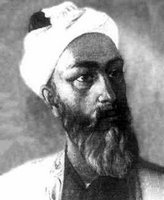Iran's Greatest Scientist, Ibne Sina (Avicenna)

Ibn Sina (980-1037 C.E.), is often known by his Latin name of Avicenna, although most references to him today have reverted to using the correct version of ibn Sina or Abu Ali sina. He blosommed during the period when Iran was influenced by Islam after the Arab conquest. He is NOT an Arab philosopher/ mathematition, as most westerns books refer to him.
The course of ibn Sina's life was dominated by the period of great political instability through which he lived. The Samanid dynasty, the first native dynasty to arise in Iran after the Muslim Arab conquest, controlled Transoxania and Khorasan from about 900. Bukhara was their capital and it, together with Samarkand, were the cultural centres of the empire. However, from the middle of the 10th century, the power of the Samanid's began to weaken. By the time ibn Sina was born, Nuh ibn Mansur was the Sultan in Bukhara but he was struggling to retain control of the empire. Ibn Sina's father was the governor of a village in one of Nuh ibn Mansur's estates. He was educated by his father, whose home was a meeting place for men of learning in the area. Certainly ibn Sina was a remarkable child, with a memory and an ability to learn which amazed the scholars who met in his father's home. By the age of ten he had memorised the Qur'an and most of the Arabic poetry which he had read. When ibn Sina reached the age of thirteen he began to study medicine and he had mastered that subject by the age of sixteen when he began to treat patients. He also studied logic and metaphysics, receiving instruction from some of the best teachers of his day, but in all areas he continued his studies on his own.
Among his works, the Canon of Medicine is the foremost, used as it was as in both the Middle East and in Europe (Latin translation in 12th century). His most renowned philosophical work was the Book of Healing (ki bu sh-shif'), dealing with Aristotelian logic, metaphysics, psychology, natural sciences and music.
Avicenna, a philosopher combining Aristotle and Neoplationism, set out to reconcile philosophy and Islam. But he denied that there was any individual soul, that God had interest in individuals, and that there had been any creation of the world. Avicenna meant that there was a dualism of mind and matter, where matter was passive, and creation had been an act of instilling existence into the passive substance. The only place where there was no such dualism, was in God.
Ibn Sina's wrote about 450 works, of which around 240 have survived. Of the surviving works, 150 are on philosophy while 40 are devoted to medicine, the two fields in which he contributed most. He also wrote on psychology, geology, mathematics, astronomy, and logic.
Ibn Sina was known to be a hard worker, he said once "I prefer a short life with width to a narrow one with length". Worn out by hard work and hard living, Ibn Sina died in 1036/1 at a comparatively early age of 58 years. He was buried in Hamadan where his grave is still shown.
Despite such glorious tributes to his work, Ibn Sina is rarely remembered in the West today and his fundamental contributions to Medicine and the European reawakening goes largely unrecognised. However, in the museum at Bukhara, there are displays showing many of his writings, surgical instruments from the period and paintings of patients undergoing treatment. An impressive monument to the life and works of the man who became known as the 'doctor of doctors' still stands outside Bukhara museum and his portrait hangs in the Hall of the Faculty of Medicine in the University of Paris. Avicenna is baried in Hamedan, in North Eastern Iran.
Map of adventures of Avicenna:
http://www.afghan-network.net/Culture/map.jpg
Pictures of Avicenna:
http://www-groups.dcs.st-and.ac.uk/~history/BigPictures/Avicenna_3.jpeg
http://www-groups.dcs.st-and.ac.uk/~history/BigPictures/Avicenna.jpeg
http://www-groups.dcs.st-and.ac.uk/~history/BigPictures/Avicenna_2.jpeg
Tomb of Avicenna:
http://www.irib.com/worldservice/nouroz/gallery/gal/ibnsina1.jpg
http://www.irib.com/worldservice/nouroz/gallery/gal/ibnsina2.jpg
http://www.irib.com/worldservice/nouroz/gallery/gal/ibnsina3.jpg


<< Home